
EXHIBITION CHECKLIST WITH BAD IDEA ANNOTATIONS AND RELATED WORKS
“BAD IDEAS" refers to a body of work that either can't be done or shouldn't be done. After merging form with environment as completely as I considered possible in the Room Constructions, I was looking for ways to further minimize the art experience. One approach was the reduction of visual art to visualized art.
Coincidental with the development of this approach was my situation as an unknown artist new to NYC and unable to realize my ideas due to no reputation, no gallery and therefore no funding for big pieces. This led me to working on project drawings which I gradually came to consider completed works. The most important effect of this was that it freed from the constraints of the reality of actually making things. Since the work didn't have to become material to be I was able to consider a much wider range of possibilities, work that either couldn't exist due to the constraints of physics or work that shouldn't exist due to being wrong in some way, (either too dangerous or too esthetically, philosophically or culturally incorrect.)
- Stephen Kaltenbach
What follows is a Checklist of all of the Stephen Kaltenbach artworks that are being shared one a day along with Kaltenbach's Annotated information about each piece where he talks about why he considers each to be a. . . BAD IDEA.
Additionally, there are other works by Kaltenbach that he wanted paired with each BAD IDEA because of similar conceptual strategies.
SEPTEMBER 1
click on the picture below to see a larger image
CAPUT, 2015, 16" x 22"
Anaglyphic Letterpress print (signed & numbered by Kaltenbach, 1/50 - 50/50) with 4 pairs of 3D glasses
$1,500 - BUY THIS PRINT (WITH GLASSES) HERE
KALTENBACH ANNOTATIONS: Memento Mori, Thinking ahead to that last few moments of life. Considering the effects of the choices one has made and the choices that still remain even in the seconds before death. The subtext is the total failure of the physical body to sustain the self. This work, CAPUT, is one of the pieces that endeavor to show a thing impossible to see in our physical reality: one's own skull. (This work is inspired by Shakespeare of course.)
KALTENBACH WORKS THAT RELATE TO CAPUT:
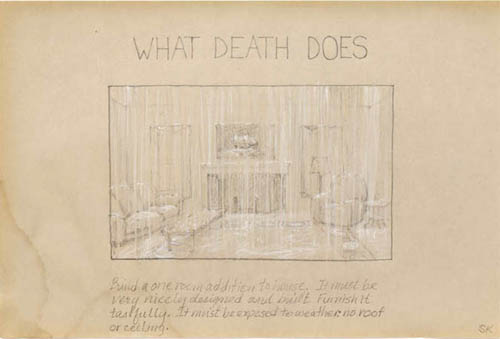

What Death Does, 1970 - Present Open After my Death Time Capsule, 1969
12" x 18", drawing on paper 3" x 3" x 6", mild steel
SOLD PRICE UPON REQUEST
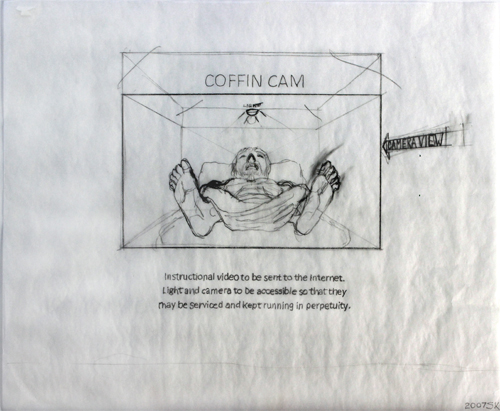
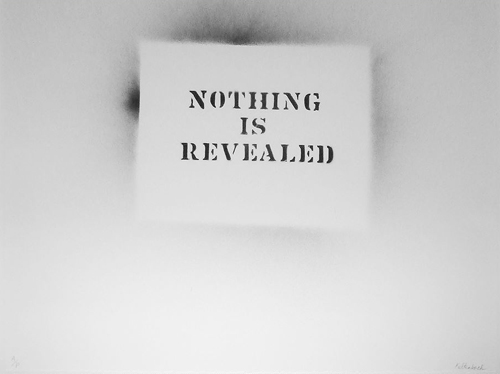
Coffin Cam sketch, 2001 Graffiti Stencil: Nothing is Revealed, 1968, Edition: 2013
14" x 17", pencil on tracing paper 22" x 30", spray paint on Stonehenge paper, numbered ed. of 20, initialed "SK"
$5,000, framed - BUY THIS WORK $2,500, framed - BUY THIS WORK
![]()
LAST WORD LAST THOUGHT LAST ACT text as the repeating pattern in the background of the CAPUT letterpress print


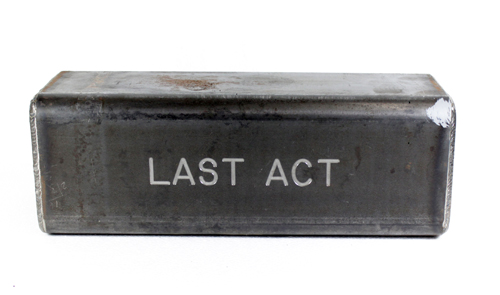
LAST WORD Time Capsule, 1970 - Present LAST THOUGHT Time Capsule, 1970 - Present LAST ACT Time Capsule, 1970 - Present
17.25" x 6" x 6", steel & unknown contents 17.25" x 6" x 6", steel & unknown contents 17.25" x 6" x 6", steel & unknown contents
PRICE UPON REQUEST PRICE UPON REQUEST PRICE UPON REQUEST
scroll down for more work
SEPTEMBER 2
click on the picture below to see a larger image
BLASTED LUNA SEAS, 2007
22" X 30", charcoal, acrylic on paper, $7,500, framed
KALTENBACH ANNOTATIONS: What would be horrible vandalism on the moon is the purpose these nukes are designed for: but for use on Earth. This piece is ICBM graffiti as a means of serious social comment. The work came about as I was thinking of the dynamics in the subculture of contemporary artists I had entered when I moved to New York City. The primary discussion among young artists seemed to be career based: how to get a gallery, museum show, collectors. The graffiti pieces, like the Sidewalk Plaques, represented a showplace environment choice that circumvented those issues and which also served to make the work anonymous. Graffiti, being separated from the art establishment, gained a nature that was equivocal rather than being fine art specific. I felt that much of its power derived from being seen by the unprepared viewer.
KALTENBACH WORKS THAT RELATE TO BLASTED LUNA SEAS:
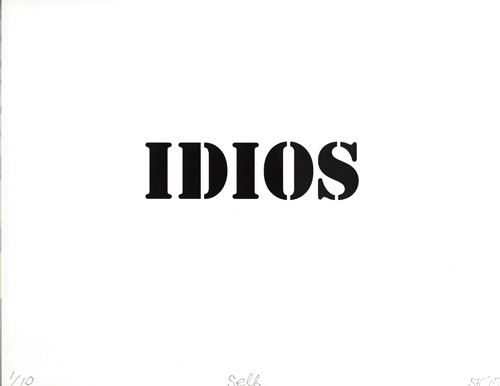
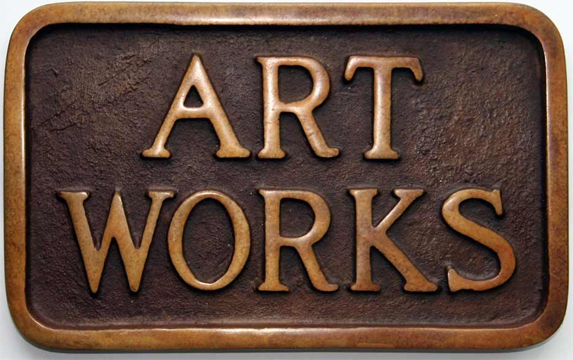
IDIOS (Self) Graffiti print, 2015, 8 1/2" X 11", ed. 10 and initialed ("SK"),
ART WORKS (Sidewalk Plaque), Bronze, 35/100, 5 x 8 x 1/2”, 1968/2010 printed with Epson Stylus Photo 2200 on Epson Matt Presentation when each one was cast (1968 as the first date), signed in the wax cast. Paper. $1,500, framed Entire edition has not been cast. $3,000
![]()
![]()
![]()
scroll down for more work
SEPTEMBER 3
click on the picture below to see a larger image
ONE, 2015,
16" x 22", Digital print of an object made to be photographed, ed of 10, $1,500
KALTENBACH ANNOTATIONS: My first real move toward Minimalism involved a shift to working with the environment instead of the object. This began with Light Ceiling, Light Floor in which I used brilliant light to separate a single plane of the room from the other five.
There is a formal connection between this piece and the work of Robert Irwin. As will become clearer throughout the month. I am very interested in the flow of ideas and esthetic vision from one artist to the next. Although I always believe that the concept I am working with is original with me I usually eventually become aware of what and how much influence has been in operation in the genesis of a work. In this instance, I was thinking of a 2D work by David E. Stone which dealt with Braille. In one of his shows, he invited his friends to make a work that would interact with one of his pieces. For that show, I made some 3D Braille bump dots. The most clear connection to ONE came from that but my mind absorbs and stores the dynamics of work I really like so who knows? Maybe Robert Irwin should accept some responsibility for the existence of today's artwork, ONE.
WORKS THAT RELATE TO ONE:

LIGHT CEILING, LIGHT FLOOR, 1966
22" x 20", graphite on paper, PRICE UPON REQUEST
scroll down for more work
SEPTEMBER 4
click on the picture below to see a larger image
DIMPLE, 2015
16" x 22", Digital print of an object made to be photographed, ed of 10, $1,500
KALTENBACH ANNOTATIONS: DIMPLE is an example of what I refer to as 'Densification'. Observing the Contemporary Art sub-culture made clear another strategy for career enhancement, the re-dating one's art to an earlier time. Thinking about this, I realized that, if freed from the reputation improvement motive, there were some interesting possibilities inherent in this action.
When making work, following the natural evolution of the conceptual basis for
art expression, there are always jumps where one piece suggests another and that
one then brings to mind a further idea. Evolving work quickly leaves gaps where
logical interstitial work could exist. DIMPLE, a concave wall piece is one
example of making work today that fits neatly in the space between my shift from
object based work to environment manipulation; which happened in 1966. This is
my version of time travel.
In another installation, Communiqué, made in 2008, I cut through the wall
entirely. There is a somewhat complicated story behind Communiqué as it was
"sort of" made by someone else. While living in New York City I was thinking
about the limitations that I had to work under as an artist, limitations such as
skill level, imagination, taste, and the rut that grows in the studio from the
developing habits of vision and thought. I decided to try working as someone
else. I made three fictitious artist's lives which I called Life Dramas and as I
always burdened them with some fatal lack of understanding of the purposes of
art, I thought of these plays as tragedies. In my second Life Drama I named
myself Clyde Dillon. I conceived this artist as a sculptor with a moderate
amount of talent and a limiting taste for rich surfaces. He was casting
decorative bronze abstractions for the upscale collector.
For Clyde Dillon I purchased an expensive suit, moustache, and wig disguise
using money from the sale of drawings for Wall Painting projects to the Italian
collector, Speroni. I felt that this was necessary because my face was known in
NYC. Then as Clyde Dillon I approached galleries to attempt to get them
interested in showing the work. I was about as successful in this endeavor as I
was in obtaining a show as Stephen Kaltenbach; which is to say, "Not so much".
This lack of success didn't bother me; after all this was an artist's life.
Over the years I felt that I should let Clyde gradually gain a deeper
understanding of fine art expression and thereby show improvement of his work.
So every decade I tried to create new insights for his art practice to
illustrate this learning curve. Communiqué illustrated this achievement which
happened between the years 2000 and 2010.
There has been a very interesting and unforeseen aspect to working with and for
Clyde. As an artist I have always thought of the evolution of my work as being
somewhat "straight ahead" or similar to the direction of time, moving through
past, present, future, one piece to the next, learning from the stream of
conceptual events that happen in the studio. Even when I have been able to split
my projects to new lines of work, I saw myself as continuing to move ahead in
the same way. Working with Clyde's art I was able to view the entire potential
pathway of his art from the side, perceiving the entire oeuvre at once. When
looking back and forth over his years of work, the logical progression of his
thought gained a surprisingly sharp focus.
I have, of course, tried to assume that viewpoint with my own work but it's much more difficult. It may be because I am so imbedded in it. (STEP BACK).
WORKS THAT RELATE TO DIMPLE:

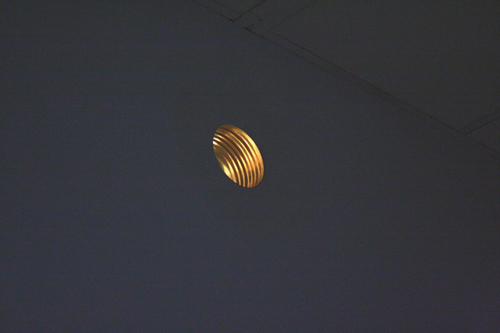
Communique by Clyde Dillon, 2000s, High Gold Hole by Clyde Dillon, 1990s,
ABS plastic in wall, ed of 5 - $7,500. ceramic, ed. of 5 - $7,500
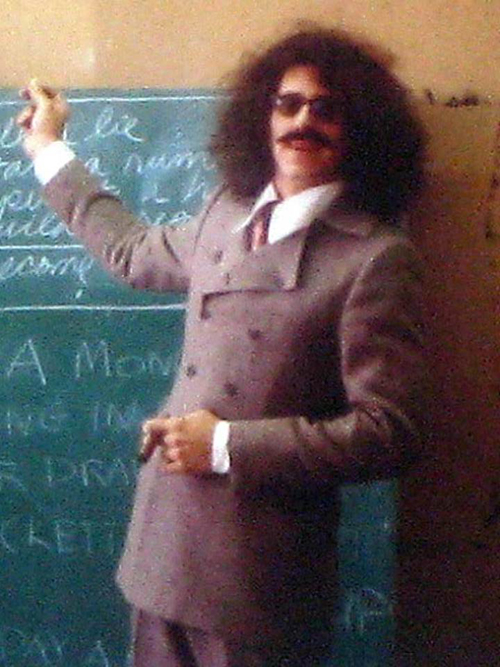

Self Portrait as Clyde Dillon, 1970 STEP BACK (Graffiti Sticker), 2014
11" x 8.5", digital print, signed & numbered, ed. of 25, $500 11" x 8.5", digital print on Avery stickers, numbered & initialed "SK), ed of 10, $250
scroll down for more work
SEPTEMBER 5
click on the picture below to see a larger image
Binary, 2009
12" x 17 7/8", Graphite and pastel pencil on news print, $5,500
KALTENBACH ANNOTATIONS: BINARY. This is another work that reveals a thing impossible to see: the sunset on a planet in a binary (double) star system. This piece should activate when the sun is lowering on the horizon so both 'suns' are visible in the same region of the western sky, one a little above the other.
Will 'O' the Wisp. This work came to me in 1968 when visiting my friend, Frank
Owen's country place in upstate New York. We were hiking at dusk and in the
twilight this piece just took form in my mind. That spontaneous appearance of a
concept is always amazing although sometimes afterwards I have a realization of
where it had come from. Usually it's a logical progression from the line of work
I have been doing. Sometimes, however, I can see the sources of influence coming
from another artist's work, which admittedly is less amazing and satisfying -
that's just human nature. None-the-less, the vectors of incoming ideas are
fascinating in and of themselves.
WORKS THAT RELATE TO BINARY:

Will O' the Wisp, 1966
22" x 20", graphite on paper
scroll down for more work
SEPTEMBER 6
click on the picture below to see a larger image
MINUS
MINUS, 2015
9" x 12", Acrylic on paper, $5,000
KALTENBACH ANNOTATIONS: These works were what I called Micro Minimalist Manifestos. The conceptual basis referred to here was the continued distillation of Minimalism: the search for a spirit or essence. I had been in New York since September - three months. By then, one intended function of much of my work was to announce a direction I was pursuing. My November, 1967 Wall Paintings were part of that intention as was the work, MINUS, which was to be painted on the big wall of the ‘young artist’s room at the Whitney opposite the door. This was to occur during my proposed incarceration there. That didn’t happen as Marcia Tucker chose a different one of the 5 proposals I submitted for my show.
I constantly worked to shrink the minimum amount of information that could be revealed and still exist as a work of art. The Secret piece in the Art of Money show was one of these.
WORKS THAT RELATE TO MINUS:
Secret Work (from the Art of Money show), 1969.
What is offered:
1. Artist’s statement: This is the secret work that was in the Art of Money show, Chelsea Gallery, New York City, N.Y. 1969. This work was hidden rather than shown. It was placed in a safe deposit box for the duration of the show. This is a secret work which will never be revealed.
2. As owner you will have a certificate of authenticity and a bill of sale which may be shown with the artist’s statement. You will own the piece but will never know what it is. (This art work may be shown and can be made available for art historical research.)

Grey Wall Painting, 1967
18" x 24", acrylic and ink on vellum, Price on Request
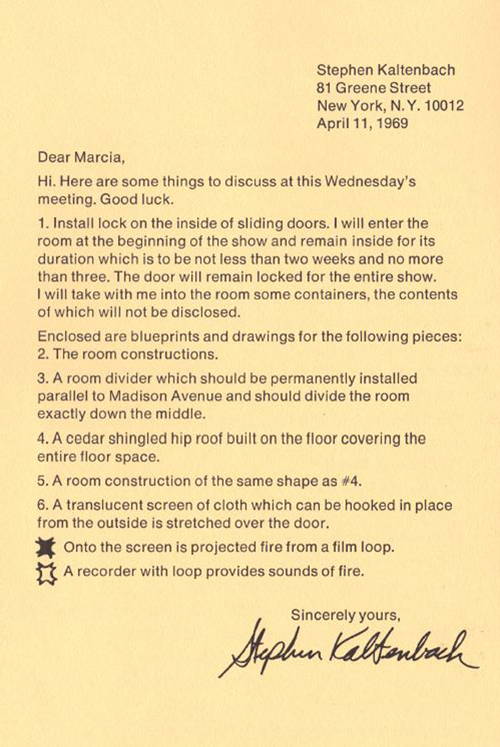
One page (with Kaltenbach's proposals to Marcia Tucker) from the Room Alterations exhibition pamphlet from the Whitney Museum of American Art
Room Alterations Whitney Pamphlet, (1969/2007)
signed & numbered, edition of 10 – $500.00
scroll down for more work
SEPTEMBER 7
click on the picture below to see a larger image
ASH GLAZE POT, 1965, from the November, 1970 issue of Artforum magazine
4" x 7.5 ", ceramic, Price on Request
KALTENBACH ANNOTATIONS: Although photographically illustrated, this is a lie; Lee Lozano would have termed it Info-Fiction. It is supported by the fact that I had previously had a toe amputated.
I considered this extreme Minimalism: the move from Visual Art to Visualized Art and the complete dematerialization of the object. Also, it was my first attempt at Alchemy: the transmutation of Bad, (a lie,) to Good, (a work of visualized art existing only in the viewers mind).
This was also my first try at the structuring of my reputation as opposed to the enhancement of it; which was one of my first uses of the “Protocol of Opposites.” This Art Action developed as I observed the involvement of my peers in building their reputations and decided to choose an opposite direction. One of the most obvious things I saw here was the embroidery by artists of their achievement by changing the date of work to an earlier time. (Build a Reputation) My interest was to work with reputation as a medium by manipulating my public image as an art expression rather than doing it for career reasons. This for the first time opened up the possibility of degrading my reputation rather than always working to enhance it. I felt like a painter who for the first time has been introduced to grays and black.
Another observed strategy artists were using was to close their studios to keep private their conceptual structures and techniques that were being used until their work was revealed to the public. Through the Protocol of Opposites I decided to publicize my ideas in an attempt to influence the thinking of my peers. This was obviously a Bad Idea and therefore challenging so I tried it out on my closest friend from art school, Ed Higgens. I gave his work a lot of thought and suggested to him my ideas that might best help him in his research. A week later I wrote and told him what I was doing. He called immediately to tell me to NOT do that; he said that people would hate me.
So naturally, now recognizing how Bad an Idea it really was, I began at once. Two things I learned right away; I had the advantage of being able to bring a fresh eye to the work while the artist had the advantage of a much greater depth of knowledge of what he or she was doing. The ‘product’ of this endeavor was really interesting in that for the first time I couldn’t “see my work”; that is, I couldn’t determine what the effects were of my observations and comments. As a corollary of the indeterminate results of these studio visits, I decided that I should keep secret what was done. So two new things emerged: art that wasn’t really perceptible and art that had to remain secret. My need for Minimalism was quite satisfied by these things.
Eventually the art of influence which I termed Causal Art moved to the Art Forum ads and into the manifesto form. This was a move in the direction of ‘Targeting’ my art toward a specific audience. With the Sidewalk Plaques and Graffiti Works I had been directing my art expression toward the unprepared viewer, hiding their nature as art by displaying them outside an art identified environment. Now with the ads I felt that I was directly addressing fine art professionals.
WORKS THAT RELATE TO ASH GLAZE POT :
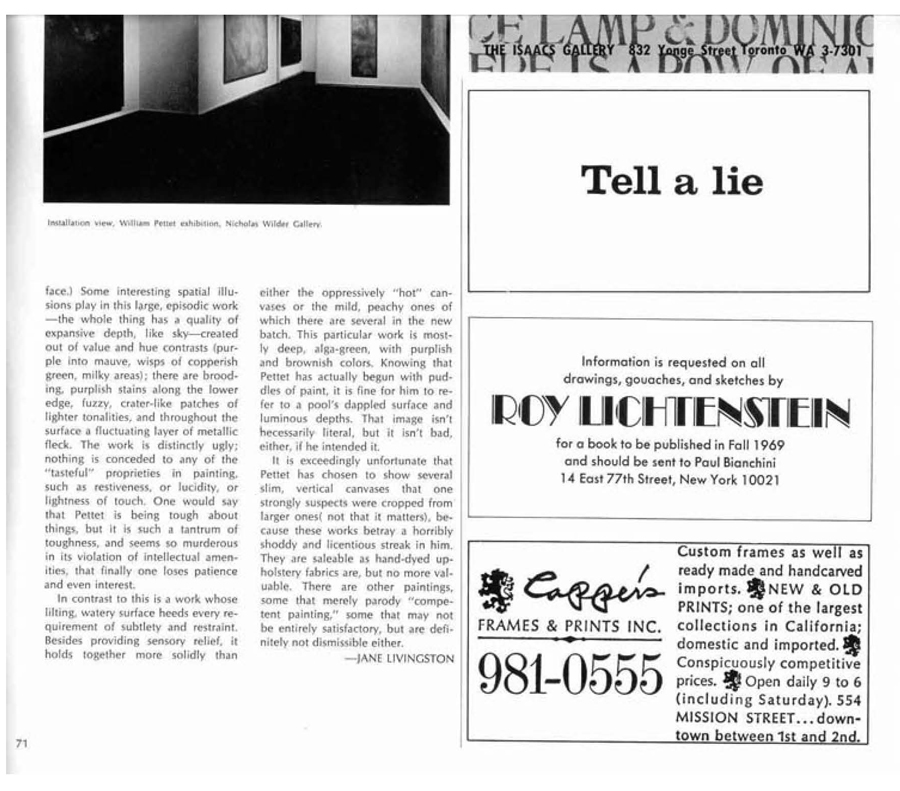
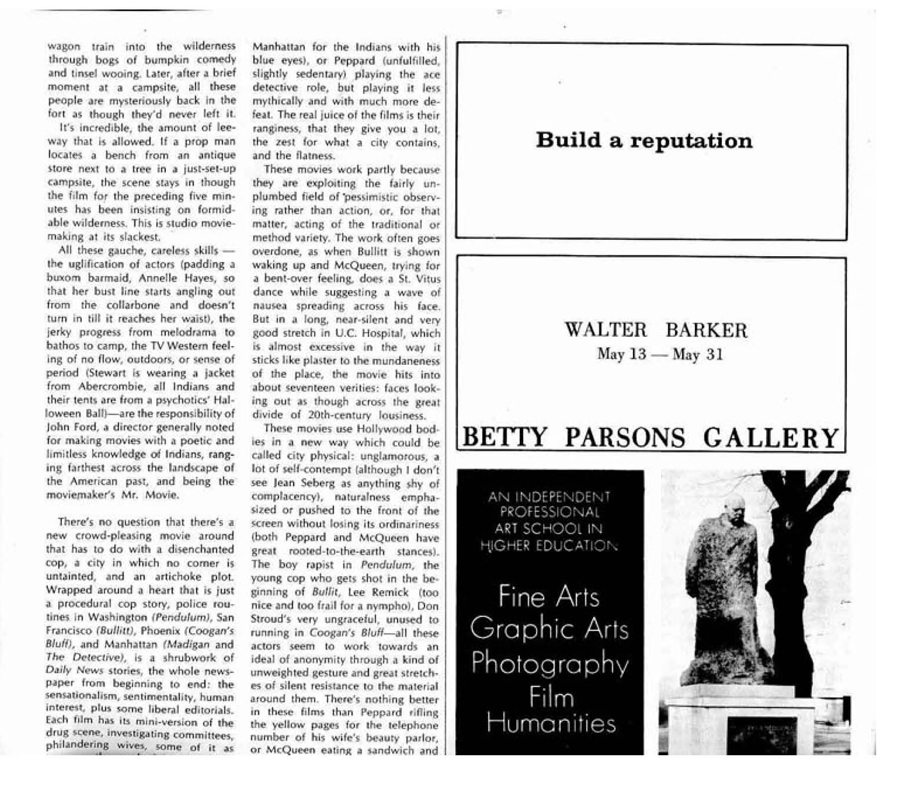
TELL A LIE BUILD A REPUTATION
Artforum magazine, February, 1969 Artforum magazine, May, 1969
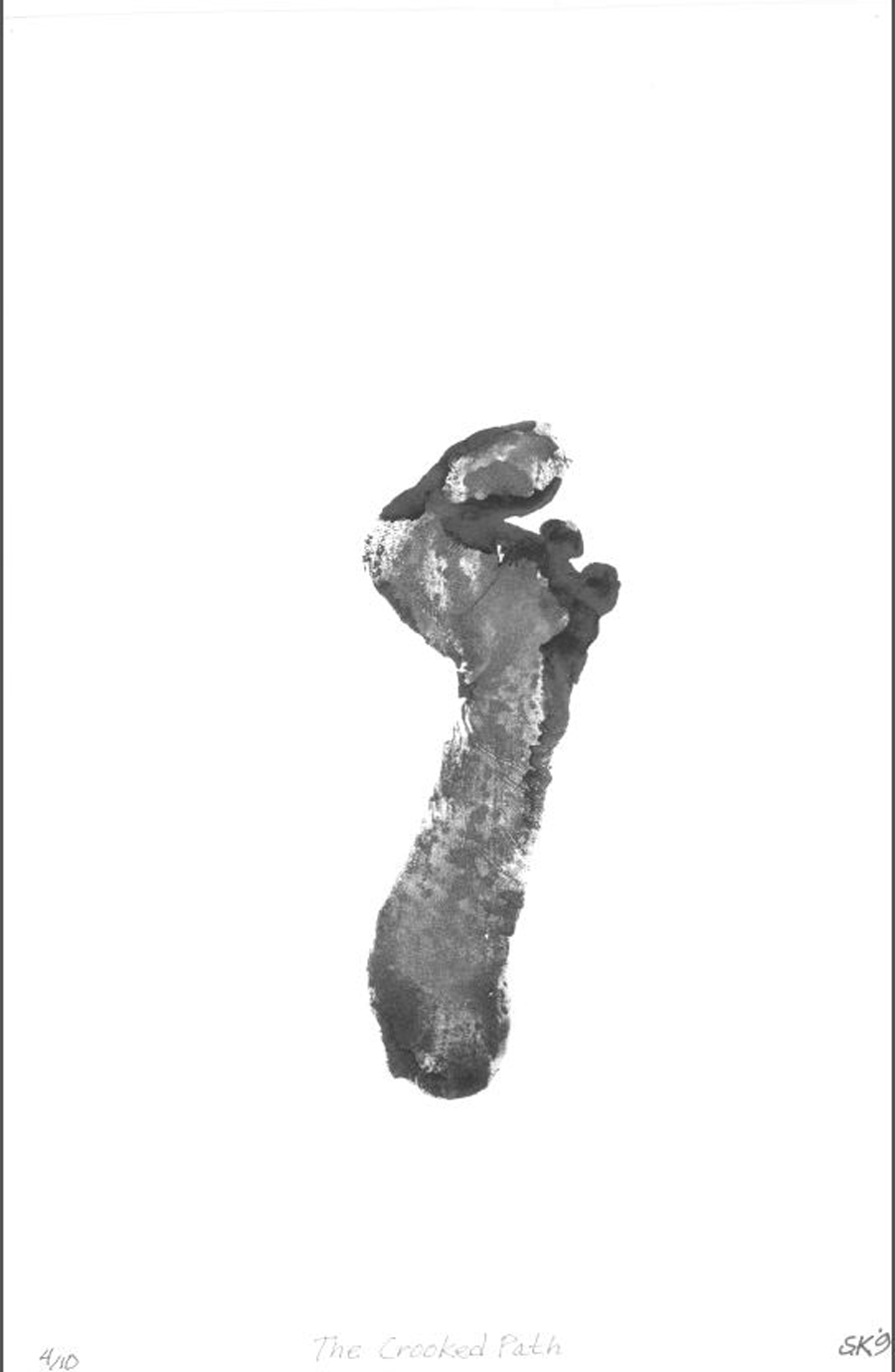
The Crooked Path, 1995
13" x 20', editioned monoprint (inked artist's right foot (missing one toe) with acrylic ink) on paper, ed of 10, $5,000
scroll down for more work
SEPTEMBER 8
click on the picture below to see a larger image
ZERO, 2011
9" x 12", graphite on paper - $5,000
KALTENBACH ANNOTATIONS: This work speaks to the most radical minimalist actions that I have come to in my work. I had been doing street works for years including the sidewalk plaques, the graffiti stencils, stamps, and stickers. I had done personal appearance manipulations on the subway and on the streets with my classes. We also performed Museum Intrusions into the Met.
When the museums began to sponsor street works I thought that ironically the character of the work had come full circle. What had begun as a personal means to show outside the establishment had become institutionalized. And with that came the loss of the precious anonymity which had given the work such mystery and even worse, that loss had removed the psychological barrier that had hidden the Fine Art nature of what was being seen. This knowledge made certain that it was art that they were viewing, and therefore no longer confronting.
For the institutional Street Works I decided to craft careful lies describing what I might have done had street works remained free of definition. Though I participated in Street Works one, two, three, and four, I never took any action other than telling my stories. I will be in a Street Works show in New York later this year which will have some of the non-existent works in it. Forty-five years later they are still being shown.
These art ‘inactions’ led to the secret pieces and the works that resulted in no change. In the group show in Burnaby I asked Simon Frazer University to put an ad in the paper advertising a local ditch digging company for the month of the show. When that was to happen I asked my brother who owned the business to withdraw his identical ad. I let the university know what was happening and they became quite upset, suspecting me of simply trying to save my brother a few bucks. So I explained Avant-Garde Contemporary Art to them; which comforted them not at all.
WORKS THAT RELATE TO ZERO:
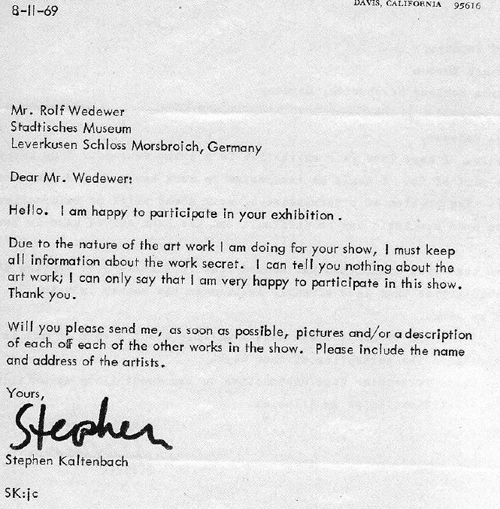
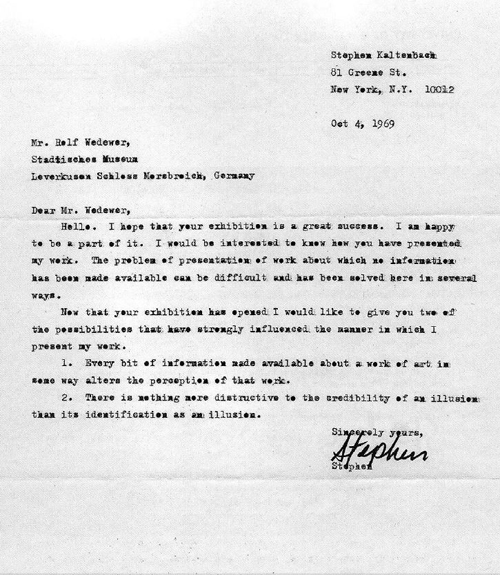
Letters to Rolf Wedewer (curator of Konzeption Conception) during the planning and following the opening of the exhibition at the Sadtisches Museum, Leverkusen, 1969
KALTENBACH ANNOTATIONS: When invited to show in the Konzeption - Conception exhibition in fall of 1969, I agreed to participate. What I kept to myself was that my involvement would consist of my repeated refusal to make any information available. Every time I received a letter requesting my piece I answered back that there was no information available at this time. This communication continued back and forth until the show opened. The result was that although I was listed as an exhibiter there was no sign of my work. That remains true; there is still no evidence of my work for that show and that reality will continue in perpetuity.
scroll down for more work
SEPTEMBER 9
click on the picture below to see a larger image
STRUCTURED NEBULA, 2008
22" x 30", acrylic on paper - $7,500
KALTENBACH ANNOTATIONS: It's not unusual for the title of a work to come to me before the details of the piece. I liked the oxymoron sense that this name provides: Structured vs. Nebulous. This is a project to arrange the stars, gas, and dust of a nebula into the form of a torus. This piece is me wreaking wanton environmental destruction. I think of it as a metaphor for everything excessive that we do. Luckily this work will remain impossible because it certainly shouldn't be done; on a cosmic scale even interesting ideas become bad. This is what we do to nature as soon as we learn how and the more powerful we become the bigger we do it. I see these works as satiric commentary on the world-destroying actions of the Military - Industrial Complex. This is my rationale for having fun with my inner Walter Mitty.
This project to restructure the cosmos into a photo-realistic image began in 1978 with the 'Crystal Ought', a painting on black velour craft paper of a star cluster with nebular gas and dust arranged to give the appearance of a crystal torus lit by a light of divine brilliance. I have painted numerous versions of this piece over the years.
In this series I often work on archival surfaces but I am drawn to working on paper that has a clearly limited life span. This is partially due to my strategy to direct my art expression toward professionals who are working in adjacent disciplines, in this case preservation. Most central to this interest though, are the poetic and philosophic aspects of the temporal nature of art. and the artist.
WORKS THAT RELATE TO STRUCTURED NEBULA:
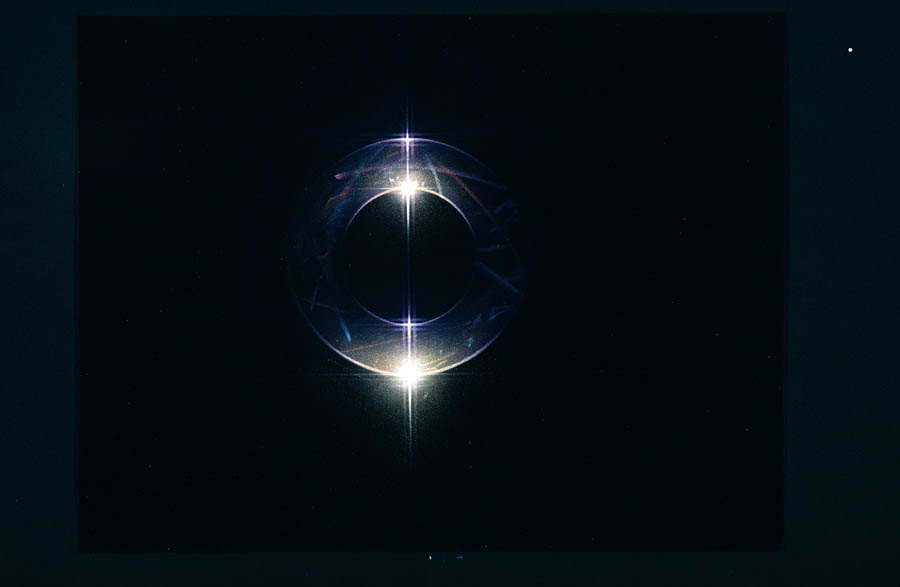
Chrystal Ought, 1978 to present
20" x 27", Acrylic and pastel, $7,500
scroll down for more work
SEPTEMBER 10
click on the picture below to see a larger image
BIOSPHERE, 2008
22" x 30", acrylic on paper - $7,500
KALTENBACH ANNOTATIONS: This soap bubble represents the fragility of our oceans, land, and atmosphere - the habitable zone on Earth; which has been compared to the thin skin of an apple. We screw it up in multiple ways and then depend on science to get us out of the jam.
I see the Military-Industrial complex as the big culprit although it is partly just human nature. I was born at the start of WWII and as a 4 year old I thought the whole thing was pretty cool, especially the fighter planes and bombers. In second grade after the war had been over for several years I was drawing tanks so well that I had more orders from my fellow students than I could fill. In movies it still retains a mysterious cache. Keeping it in the realm of art, even bad political art, seems the way to go. Otherwise this scale of conflict is just too destructive on the population and the environment. Even worse, it gives us bigger and better weapons that have reached the point where ultimately they can make our biosphere permanently uninhabitable.
Even without tools of war, we cause severe damage to the planet through destructive industrial practices; which are allowed and even encouraged by governments that are subservient to corporate entities. Environmental damage is clearly out of control but there are still spokespersons representing corporations who deny that there's anything wrong.
We finally admit that we are in trouble but the solutions that are being studied often bear potential dangers of their own which can't be adequately studied in the lab. That poses the problem: if they are tested in the field, what happens when things go wrong and a more dangerous threat is released into the world. I am made apprehensive by our habit of creating environmental crises and then trying to fix them with the same science through which they came into being.
WORKS THAT RELATE TO BIOSPHERE:


TROPICS DIET, 2007
8 1/2" X 11", ed. 20 and initialed ("SK"), printed with Epson Stylus Photo 2200 on
Epson Matt
Presentation
Paper - $1,000
scroll down for more work
SEPTEMBER 11
click on the picture below to see a larger image
FLAMING EIGHT BALL, 2002
22" x 30", charcoal, acrylic on paper - $7,500
KALTENBACH ANNOTATIONS: We are behind "the eight ball". This term refers to a situation in the game of pool in which a player is trapped with very few options. The hope in this situation is that with enough skill a shot can be made. With these Nuclear Space Works I feel like the guy walking around with a sandwich board yelling, "The end is near."
Once you grow up under "The Bomb" you are left with a certain amount of pessimism. In grammar school I remember the atomic attack drills when we got under our desks, curled up in a ball and with our face to the floor waited to be vaporized from back to front. I never saw much advantage to that. Then when the Cuban Missile Crisis escalated to the ultimate confrontation, I begged my brother to not go to work in San Francisco because the city was targeted by Russian ICBM's. The world did not end in fire that day; the U.S. Navy played chicken with the Russian Navy and they came to a mutual decision to postpone Armageddon. Later, I was told that if San Francisco had been nuked, the temperature would have reached 375 degrees where we lived 50 miles north. With these nuclear projects in which I use fission and fusion bombs as media, my goal is to use it all up: no more media, no more problem.
I like to think about the influence that art has on my work. In these terms, one of the most important art experiences I have ever had was seeing the film, Dr. Strangelove. In the theater I found myself, incredibly, laughing at the horror of the destruction of the world. That was one of my earliest and most clear encounters with irony.
IN MEMORIAM
In shock we inhale,
Breathing the innocent ash
That rains on New York.
WORKS THAT RELATE TO FLAMING EIGHT BALL:


THE END, 2004,, “LA Story”(“The End”), 2004
Unlimited Edition book, published by $15.95 on Amazon Same book with rubber stamp additions & signed/numbered edition of100 - $250
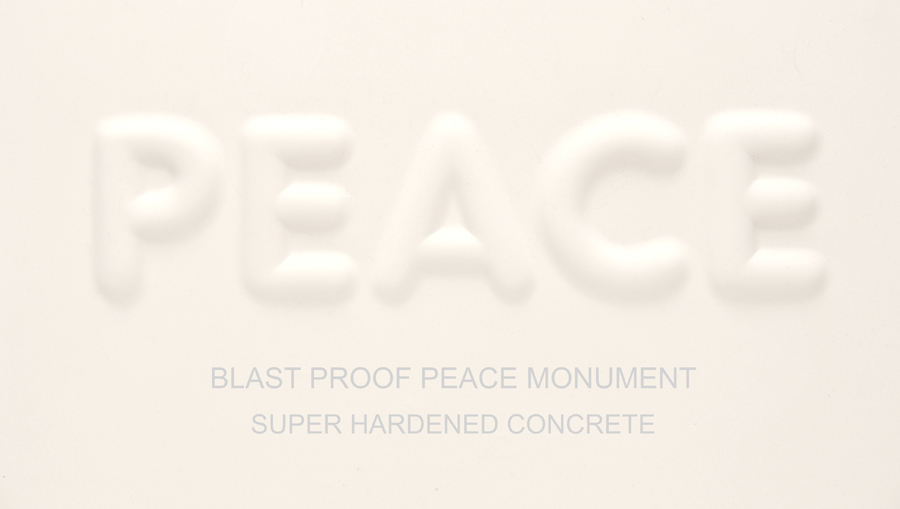
Model for a Blast Proof Peace Monument, 2002.
21 7/8" x 15 x 1 1/8'', Fortified concrete, edition of 20, $5,000
scroll down for
more work
SEPTEMBER 12
click on the picture below to see a larger image
FURNACE, 2007
acrylic, graphite on paper - $7,500
KALTENBACH ANNOTATIONS: This represents an absurd solution to our need to turn down the world's thermostat. In the annotations for 'Biosphere' I spoke of our repeated creation of environmental situations which threaten the livability of our Planet Earth. The situation is complicated by the fact that there are 'natural', that is to say non-manmade causes for some of these things. The problem is that people want to argue that we don't have to be concerned about things like Global Warming because it may be the result of natural phenomena. Why this makes some of us comfortable doing nothing is a mystery. It seems also excessively dangerous. If there are indeed increases in the amount of solar energy we are receiving, it's even more crucial that we do everything to minimize our habits that exacerbate the situation. The solution represented by 'Furnace' is actually closely allied with some strategies that have been put forward as ways to mitigate the situation created by our excessive use of fossil fuels.
scroll down for more work
SEPTEMBER 13
click on the picture below to see a larger image
S' FEAR, 2009,
6 feet diameter, Steel, Digital cd player and speakers, Price on Request
KALTENBACH ANNOTATIONS: This work is a steel sphere six feet in diameter. The narrative is that this container has a vacuum drawn in it. The reference is to fear as that hollow feeling in the pit of the stomach. To represent this extreme emptiness in the sphere I used the sounds of steel being compressed and crushed by the pressure differential as heard on the soundtracks of countless submarine movies. This vast emptiness is an actual sensation that fear causes. I have experienced it so clearly that I have even had adequate thought space to notice it and think about it as it was happening.
WORKS THAT RELATE TO S'FEAR:
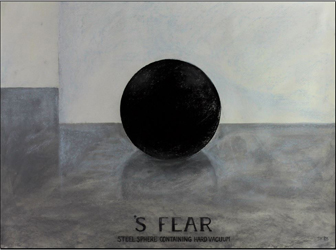
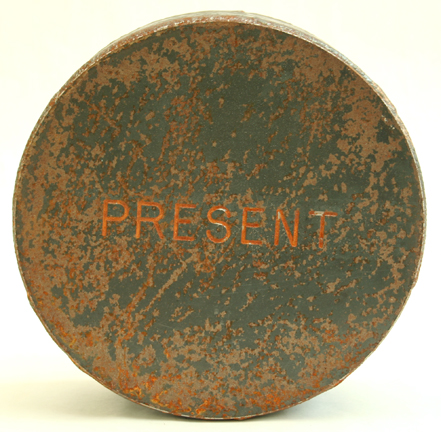
S'FEAR, 2007 PRESENT, 1970 - Present
22x30", Charcoal and Graphite on paper, $7,500 10 7/8" x 19 7/8" x 4", Steel, Price on Request
scroll down for more work
SEPTEMBER 14
click on the picture below to see a larger image
VORTEX, 2011,
9x12", Graphite on paper, $5,000
KALTENBACH ANNOTATIONS: This work is from a series started in 1968. They are project drawings for projections of film or slides. They were mostly designed as museum pieces to be projected on walls. In this work I was interested in the shift of the horizontal plane of water 90 degrees to the vertical.
The maelstrom, from Dutch for 'whirling stream,' actually exists in many places in the oceans of the planet. I've loved this idea since I was a child. I have a faint memory of a story illustration of a giant one with a sailing ship going down in it. The image seems a great metaphor for the bad times in life when things are spinning out of control like a run-away train. Then there is the positive side, the roller coaster or the silent movie baby buggy that gets away from the mom on a steep hill and goes flying down the street through intersections, barely missing cars while the baby screams not in fear but with delight.
Fire on Ice is the one of this series of projections that was not intended to be on a wall. It is the only one that has been realized, a happy event for me which is obvious from the rather big grin on my face during the construction of the ice cube. This piece is in the Marzona sculpture park in Versegnis, Italy. Egidio Marzona owns the work so whenever he decides to show it he hires stone carvers to make it out of blocks of ice using chainsaws. This event happened in November, 2007 which was cold enough so that it lasted until it rained a few days later.
WORKS THAT RELATE TO VORTEX:
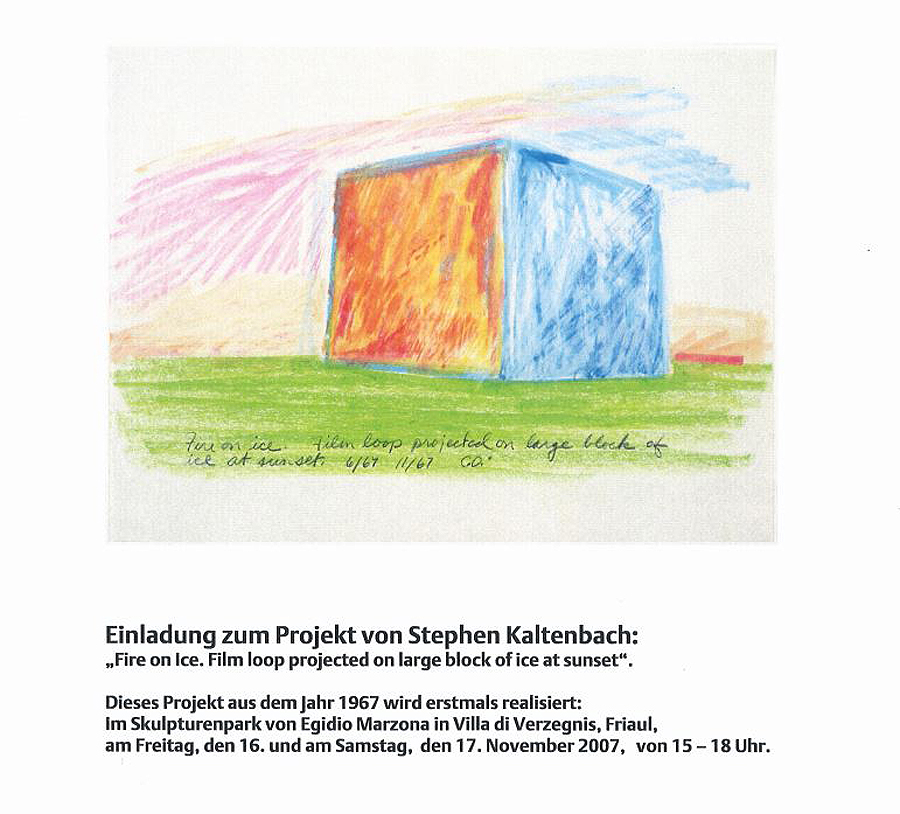

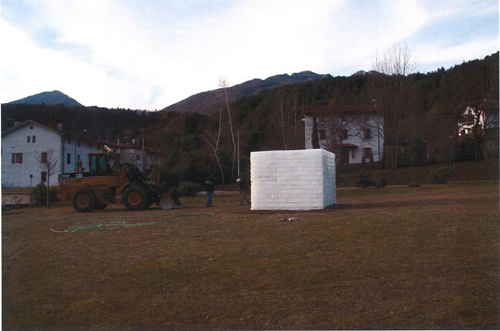
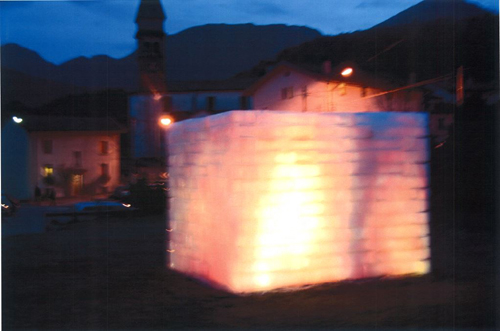
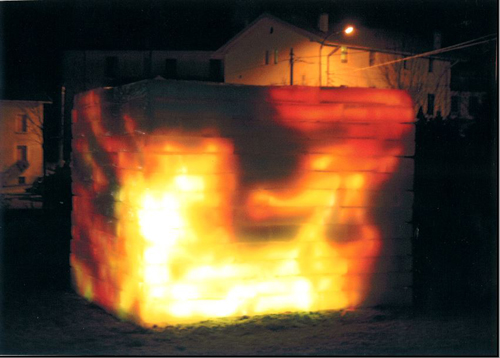
scroll down for more work
SEPTEMBER 15
click on the picture below to see a larger image
BLACK HOLE, 2006
22x30, 2006. Charcoal, Graphite, acrylic on paper, $7,500
KALTENBACH ANNOTATIONS: I became interested in a blacker black when I started painting the Chrystal Ought. That black velvet was a step darker than black paint and as a corollary the whites were a step brighter. The idea of a hole into the museum wall opening into a black velvet lined box began as a concept of a mirror into darkness where not only was there no reflection, but there was no light at all coming back out.
I have been interested in the mirror as an entry into making installation work since the early seventies. The piece that was at the center of this thinking was an installation called The Window. This is a room with objects in it including a mirror that reflects everything in the room except the people. This work is very complicated, requiring ten pairs of objects that are exact mirror images. This work was built by my sculpture class in 1982.
WORKS THAT RELATE TO BLACK HOLE:
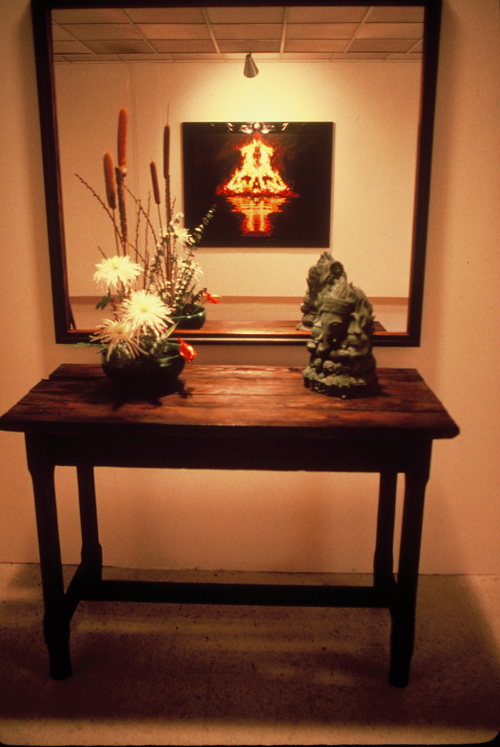
scroll down for more work
SEPTEMBER 16
click on the picture below to
see a larger image
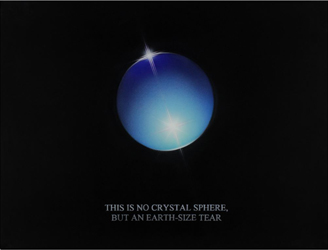
EARTH SIZE TEAR, 2005
22x30, charcoal, graphite, acrylic, $7,500
KALTENBACH ANNOTATIONS: When I made this piece I was thinking that this was not a prophecy of a dire future but a dire present. Even for people blessed by life in a country with a stable government and sufficient resources to provide the basic necessities, life is sometimes hard. For people living in failed states that don't have adequate food and shelter and have no prospects of seeing things improve, life is really hard. In a world where people became unselfish and kind things could be better. I live with this feeling that I could do more to help.
scroll down for more work
SEPTEMBER 17
click on the picture below to see a larger image
22x30, Graphite, acrylic on paper, $7,500
KALTENBACH ANNOTATIONS:
This is a time capsule, a stainless steel
container at least 12 feet in diameter. It is to contain the annual commentary
of the people of Earth that has been collected selected by a series of curators
for one thousand years. After a millennium it is to be opened and the contents
made available to scholars. I am interested in creating a running commentary on
the times that our civilization experiences. This is what happens anyway as
events and the evolution of consciousness flow down the time stream and the
interests and imperatives of the human family evolve. I would however like to
see the effects on the historical record of a purposeful accumulation of the
thoughts of people from all walks of life who are interested in speaking to
their posterity.
This work in my mind is a most positive take on the future of our civilization, a culture which is educated and retains scholarly pursuits such as history. The options are, a thousand years of peace or the recovery from the ravages of limited war. This will be meaningless if we descend into another Dark Age by nuclear holocaust or world conquest of an adequately repressive dictatorial state that disallows freedom of thought.
The KLEINES KLOSTER Time Capsule is not a container but rather a pin-hole camera, so that if you face it, your image is projected on the back wall inside. This represents the path of inaction as a response to difficult times, a retreat. The possibility of withdrawing into a monk's cell-like space facilitates the turning inward to seek answers, that quiet communion with the soul and spirit. This is old knowledge.
WORKS THAT RELATE TO TIME WILL TELL:


KLEINES KLOSTER , 1970 - Present, TEACH ART , 1970 - Present,
5" x 5" x 5", Steel, Price on Request 4" x 4" x 14", aluminum, Price on Request
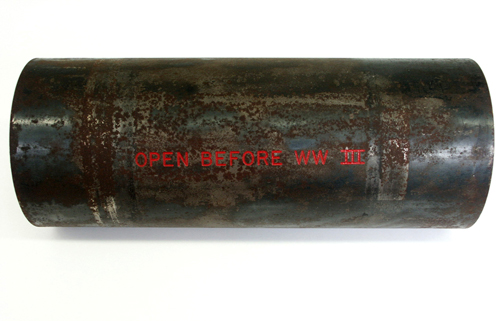
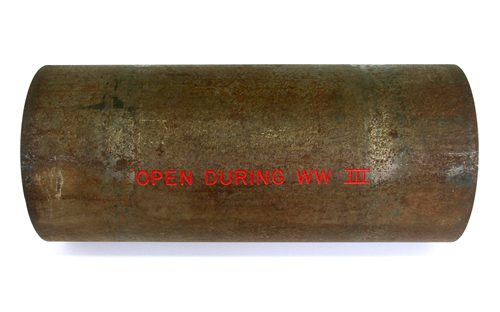
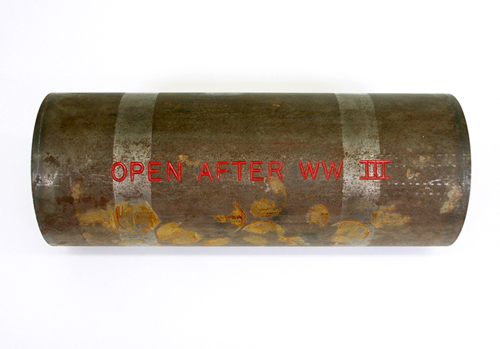
OPEN BEFORE WW III , 1970 - Present OPEN DURING WW III , 1970 - Present OPEN AFTER WW III , 1970 - Present
6" (diam) x 16", Steel, 6" (diam) x 16", Steel 6" (diam) x 16", Steel
Kröller-Müller Museum, The Netherlands Kröller-Müller Museum, The Netherlands Kröller-Müller Museum, The Netherlands
scroll down for more work
SEPTEMBER 18
click on the picture below to
see a larger image

NIGHT BLOSSOM, 2015,
22" x 30", pastel on paper, $7,500
KALTENBACH ANNOTATIONS:
This sculpture work is about modifying the visibility of a three
dimensional object. This is work directly connected to my Minimalist Strategies.
A way to reduce the release of information is to make it less visible. This low
visibility work is an extension of the Minimalism of the Time Capsules as well
as the secret pieces which function on the same principle; that of keeping the
nature and substance of the art expression in the dark. With the Time Capsules,
the work inside is ostensibly only hidden for a period of time; which gives the
sense that the contents may only be available to a future generation. In
actuality the secrets enclosed may be hidden for much longer. As fine art owned
by private collectors or institutions, these works become somewhat invulnerable
to the saw. It's frowned upon to cut fine art in two. But then if this thought
is extended far enough into the future the art becomes artifact which is much
less safe from the depredations of more thorough investigation.
The strategy of hiding information combined conceptually with the pieces in which I attempted to work within myself in some way. With the 'Wound Prints' I began to use my blood as medium. The 'Personal Appearance Manipulations' were works directly using myself. Both of these were the precursors to the Life Dramas.
These thoughts of hiding combined conceptually with the 'Self' works to suggest the 'Life Dramas', the last of which is the ('Regional Artist'). This project took a lot of thought and required me to strongly hold to my strategies. I decided to disappear as a contemporary artist and to become a regional artist by withdrawing from the international art scene and by finding a small city where I could pursue my painting and sculpture while making conceptual art privately.
I worked in the city, Sacramento, but I also moved to a barn in the country which had no address. People who were associates could write me there care of my land lady. I had no phone, no bathroom, and no hot water. I worked there free from the flow of public production and criticism. My motivations were partly to see what would happen to my contemporary art. I wondered how much it needed me to be there backing it up with continual new projects? In New York my art had consisted of manifestos and work that was intended to create influence. I had found that discerning the effect of my 'Causal' art was impossible, an aspect of my work that was pleasing to my sensibilities. It met my need for minimalism perfectly: art work that was not only invisible but that was impossible to determine if it even existed. I did think that my absence might clarify the effect on art that my conceptual processes might have had. For more information, see the Artforum article, Alter Ego by Sarah Lehrer-Graiwer in the September, 2010 issue.
WORKS THAT RELATE TO NIGHT BLOSSOM:

One page (with Kaltenbach's A Short Article on Art Expression) from the Room Alterations exhibition pamphlet from the Whitney Museum of American Art Room Alterations Whitney Pamphlet, (1969/2007), signed & numbered, edition of 10 – $500.00
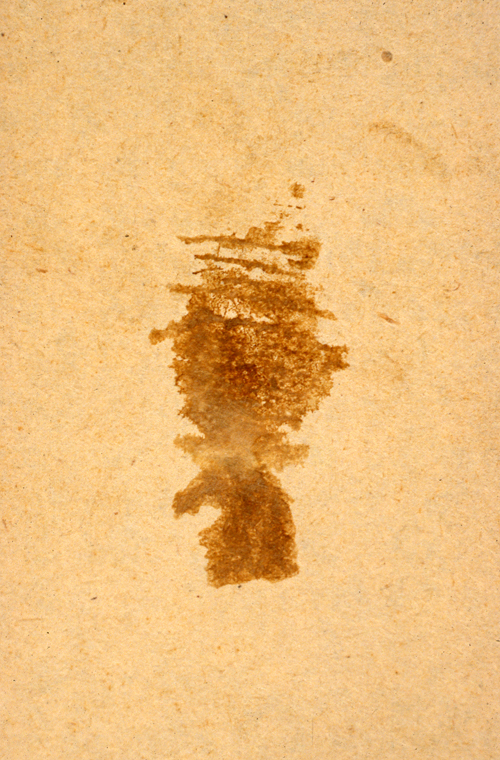

Wound Print, 1968 Personal Appearance Manipulation - Mirror Coated Contact Lenses, 1970
7" x 4.2", Paper and artist's blood 14" x 18" Photo collage

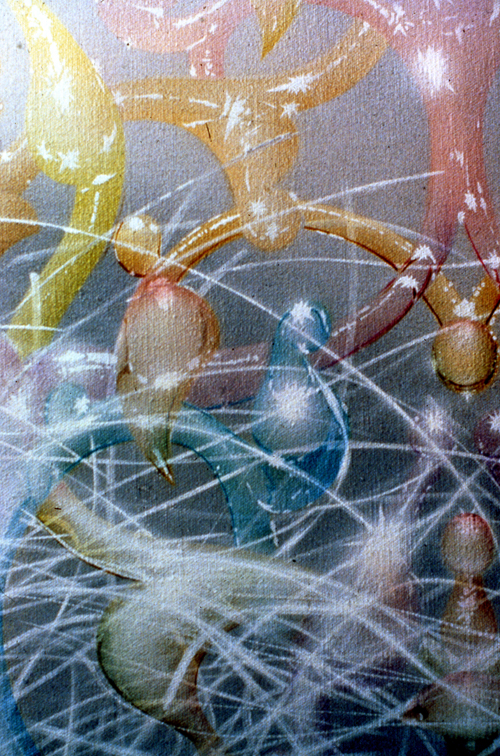
Portrait of My Father, 1972 - 1979 Detail
10' x 15', Acrylic on Canvas, Collection - Crocker Art Museum, Sacramento, CA

Time to Cast Away Stones,
1998
7' x 6.5' x 65', concrete composite, public art installation in Sacramento, CA
scroll down for more work
SEPTEMBER 19
click on the picture below to see a larger image
STRUCTURED FIRE, 2015
22x30", acrylic on paper (this painting is to be viewed in ultraviolet light), $7,500
KALTENBACH ANNOTATIONS:
This painting is a plan for a wall installation which is an
arrangement of 'book grained' fluorescing minerals that are enhanced with
fluorescent paint. These projects are an outgrowth of my Interest in radial and
bisymmetry; which was a development of my psychedelic experience. This
hallucinogenic vision I received during a Mescaline trip is also the inspiration
for the design of the paintings for 'The Window' installation in 1982, the
bisymmetrical cloud photos that were done from 1969 to 1972, and the pattern
paintings done from 1970 to 1979. (see Sept.18 link for Portrait of my Father.)
WORKS THAT RELATE TO STRUCTURED FIRE:


ALIEN, 1969 CLOUD HAWK, 1969
18"x 12", Print on Noritsu Metallic 12" x18", print on Noritsu Metallic
scroll down for more work
SEPTEMBER 20
click on the picture below to see a larger image
FIRE HOLE, 2015
22" x 30", Fluorescing acrylic on paper, $7,500
KALTENBACH ANNOTATIONS: This installation is half of a two piece work titled 'Brother Sun – Sister Moon' that is to be set into a museum wall on each side of an entrance into the room. This installation consists of a 9" circular opening that is made of insulating brick that replaces the door of a ceramic kiln. During the hours that the museum is open the kiln is kept at 2100 degrees Fahrenheit which is an extremely brilliant orange color. The piece, (obviously), will have to be guarded and eye protection may be necessary.
WORKS THAT RELATE TO FIRE HOLE:
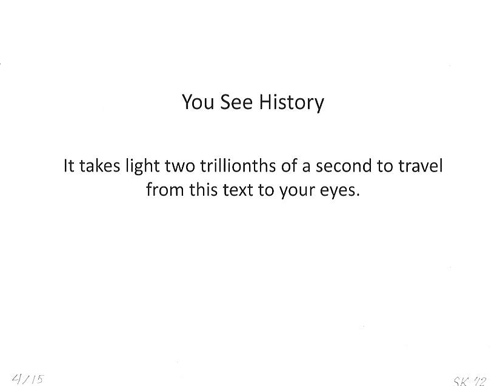
YOU SEE HISTORY,
2012,
8 1/2" X 11", ed. 10 and initialed ("SK"), printed with Epson Stylus Photo 2200 on Epson Matt Presentation Paper, $1,500, framed
SEPTEMBER 21
click on the picture below to see a larger image
COLD HOLE, 2015
22" x 30", cut black paper with white paper adhered to the back, $7,500
KALTENBACH ANNOTATIONS:
This work is a circular hole set in the museum wall; which opens
into an ultraviolet lit space. The fluorescing material visible through the hole
may be white cotton cloth or a plastic that shines equally as bright. There is a
concealed source of extremely cold air that flows from the opening. This may be
accomplished by an industrial air conditioner or by the installation of a
physics research refrigerator that can reach at least minus 87 degrees
Fahrenheit.
WORKS THAT RELATE TO COLD HOLE:
print_A.jpg)
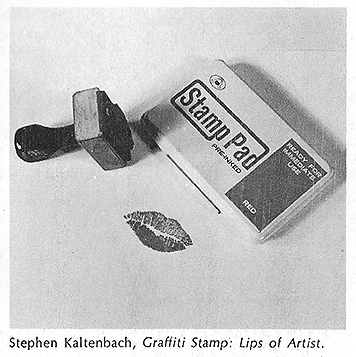
LIPS (Kiss) print, 2005,
Artforum, November 1970
5" x 7", ed. of 100, rubber stamp impression from the original Stephen Kaltenbach Lips
rubber stamp, $250
scroll down for
more work
SEPTEMBER 22
click on the picture below to see a larger image
PINK SPOT, 2015
22" x 30", Acrylic on paper,
$7,500
KALTENBACH ANNOTATIONS:
This work is made by imbedding strobe lights in a wall. They
should be arranged in a disc shaped pattern three feet across. The array is to
be set behind red Plexiglas. The room should be moderately dimly lit. The
strobes are timed to flash at irregular intervals approximately every thirty
seconds. The firing of the strobes will generate an afterimage of the
complementary color.
I became interested in putting things into the wall that looked like they were on the wall. Dimensional Mirror, which was made in 1970, was a mirror that was nine panes of glass layered. It was about two inches thick. I set it into the wall and framed it so that it looked as though it was hanging. The only image that I have is of me making a scary face in it. It gives me the creeps now but then I was still immune to the creeps.
This work operates on the principle that one trusts the nature of what is seen to be what it appears to be.
WORKS THAT RELATE TO PINK SPOT:
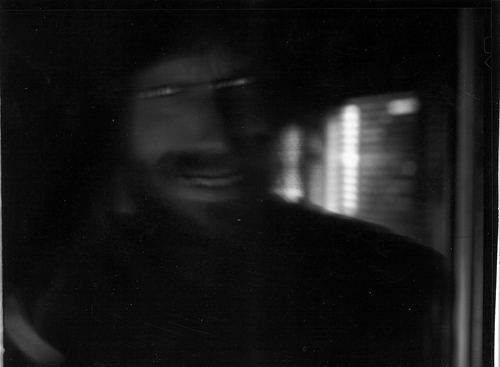
DIMENSIONAL MIRROR
scroll down for more work
SEPTEMBER 23
click on the picture below to see a larger image
STELLATED MOON, 2008
22" x 30", Acrylic on paper
KALTENBACH ANNOTATIONS:
This ambitious Lunar Work is to be created by huge 'earth' moving
equipment, bulldozing the moon's surface into this geometric form: a stellated
polyhedron. This is clearly a problematic project in any number of ways; not the
least of which is the budget that will be so great as to require the diversion
of the entire Earth's military defense budget for the next few thousand years.
The facets of this sculptural work should be carefully rendered and colored as shown. This transformation may be considered to be too hard-edge contemporary to kindle much romantic moonlight dalliance but that is not an immediate concern; it is, after all, quite difficult to get these big projects funded.
WORKS THAT RELATE TO STELLATED MOON:


Freeway Earth Mounds, 1967, 18" x 24", blackprint Excavation, 2009, 18" x 23 1/2", Graphite on paper

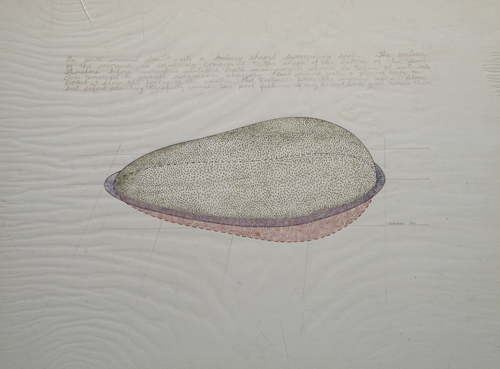
EndlessTrench, 2009, 18" x 23 1/2", Graphite on paper Earth Mound For A Kidney Shaped Swimming Pool, 1967
18" x 24", felt tip pen on paper
scroll down for more work
SEPTEMBER 24
click on the picture below to see a larger image
22" x 30", Acrylic on paper,
$7,500
KALTENBACH ANNOTATIONS:
This piece is not only bad but it is ridiculously bad. As the Big
Bang theory represents the beginning and evolution of physical nature, there
existed nothing before it. Just plain no matter. This makes materials to fashion
a mold hard to come by. Being before time, there is also no time to make it no
matter how fast one might work, making it impossible no matter how you view it.
The scale isn’t necessarily a problem, as the container could be very small if
it were in place early enough (during the first fraction of a millisecond), but
whatever the size it would have to be very strong.
This impossibility is the best part of this really terrible idea because the
balance of the nature of existence is so finely tuned that changing its shape
would have inevitably altered the physical character of the universe, probably
rendering it uninhabitable. It would have made life and therefore also biology,
chemistry, and astrophysics, impossible. This observation that the universe is
perfect for us was realized in two phases. The first was that the way our Earth
and its immediate environment are laid out is supportive to human life. Many
things had to be just as they are for this to be, and therefor for us to be.
An abbreviated list of the requirements for life on our world includes: a
suitable solvent (water), a pleasant climate (a Goldilocks Orbit), energy (the
sun and some chemicals), time (to get our cellular organization together -
unless you are a creationist as I am), CO2 recycling via plate tectonics to
support global warming (yes, we need a certain level of it to keep us thawed), a
civilized sun that gives us a nice steady level of solar radiation, plus our
magnetic field which further shelters us from our star’s occasional bursts of
extra energy. For more detail see internet.
To those who want this to all be an effect of chance, this serendipity has been
explained by assuming that the universe was so large that it was inevitable that
a friendly environment would happen somewhere and we, as luck would have it,
live there. If you want to avoid faith this is not a bad excuse. But then…
Then the second phase where a much bigger problem arose, that of the Higgs
boson. This is a situation which requires an even bigger coincidence. Apparently
its tiny mass which allows big, complex structures like the galaxies and us to
form is quite a bit too small. I admit that I don’t have the understanding to
explain this, but I read that the energy required to create the things that we
need like solar systems and galaxies is 100 quadrillion times short of what is
necessary. 100 quadrillion times less. That’s one in 100,000,000,000,000,000.
That’s seventeen zeros. Not a good bet.
This may be where the religion or hypothesis of the Multiverse was born. There
had to be so many chances for this perfect balance of energy to happen that not
only did we have to be in the select neighborhood in the universe, but we had to
have an infinity of universes from which to choose that sweet spot, due to the
long odds. The Multiverse is an idea that requires a lot of faith to elevate it
from hypothesis to theory because applying the empirical method to the problem
is not currently possible and may never be.
To believe or not to believe, that is the question, and it comes
down to a choice. For Christians it seems that the answer is to go for it no
matter what people think. For atheists the answer seems to be avoiding it at all
costs, which I believe are considerable.
WORKS THAT RELATE TO BIG BANG BOX:
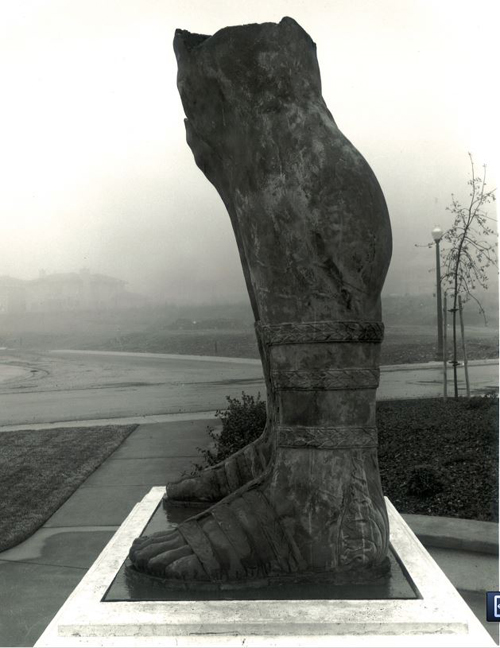
BRAZEN by Stephen Kaltenbach, 1986
scroll down for more work
SEPTEMBER 25
click on the picture below to see a larger image
SUN FLAKE, 2012
22" x 30", Digital Print, $7,500
KALTENBACH ANNOTATIONS: This is an alternate plan to collect solar energy. Solar panels would work constantly beaming electrical energy to the Earth. Because this is also an art work for the evening sky, the orbit should be such that the scale would be large enough to appear at least twice the lunar diameter.
There has been a study indicating that we have, (mostly within the last couple centuries,) burnt approximately one half of our underground biomass, the bequest of the dinosaurs and the plants they ate and snoozed under. As they won't be giving us any more, the plan we need is one to convince Big Oil that there is a great deal of money to be made in producing solar power and other alternative sources of energy.
This work is a good but funny example of how my artist's ego works. When this piece came to mind, I was well satisfied that it was a product of my imagination. I call this the pride of origination. Then one day I was rereading a favorite science fiction book titled Komarr by Lois McMaster Bujold. I had first read it maybe three decades before. In it is an orbital power station called a Starflake - so much for my originality. I comfort myself, "Oh well, everything finally becomes anonymous anyway."
WORKS THAT RELATE TO SUN FLAKE:
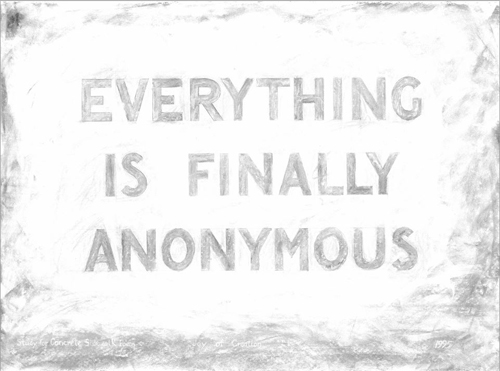
EVERYTHING IS FINALLY ANONYMOUS, 1995
22" x 30", pastel on paper, $7,500
scroll down for more work
SEPTEMBER 26
click on the picture below to see a larger image
STARRY NIGHT, 2015
22" x 30", Acrylic on paper, $7,500
KALTENBACH ANNOTATIONS:
This cenotaph is a large black helium balloon that is at least
twenty feet in diameter. It has on it the entire night sky with all of the
visible stars represented with twinkle lights. The lights should be of
appropriate size to match the stars they represent. It should be unobtrusively
tethered with a black line.
My relationship with balloons began when I was three when I had to pop my
brother's balloon because I accidentally popped mine. I'm sorry for that, David
and sorry that it's 72 years after the fact.
I was next attracted to balloons when I was in the US Navy. The aerographers
would be lofting weather balloons off the fantail while I was swabbing the deck.
Their job looked much more fun than mine so I asked about it and found that my
G.C.T. test, (aptitude test.) qualified me for weatherman school. When I learned
that I had to sign for a longer enlistment I was torn but then I decided that I
really wasn't; there was no way I wanted more of the Navy than I was already
committed to.
Then in 1969 came Balloon Fooey. It was an exercise I devised for artists. All
that was required was a large studio and a supply of balloons. And, I should
add, a high threshold of embarrassment. It is a pseudo martial art in which you
kick balloons around trying to keep them up in the air. I liked that I didn't
have to go to the gym. Doing that over the years, I kept quite fit.
WORKS THAT RELATE TO STARRY NIGHT:
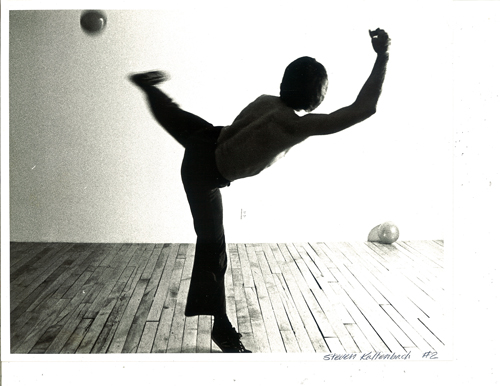
BALLOON FOOEY, 1980
8" x 10", Black & White Photograph by Alan Kikuchi
scroll down for more work
SEPTEMBER 27
click on the picture below to see a larger image
CHILD'S CLOCK FACE, 2008
22" x 30", Acrylic on paper, $7,500
KALTENBACH ANNOTATIONS:
This is the face design for a nursery clock. At ten after ten and
ten before two the clock plays 'Happy Days are Here Again'. As is obvious from
some of these works, I am interested in what I refer to as 'Soft Art". These are
pieces that are kitsch in the sense described so well by Clemet Greenberg. This
is art that is comprehensible to people who have not been trained to look at
art. Usually there is a distinct lack of irony in the content.
This interest began in 1968 when an artist named Tim Lambert stayed with me while searching for a loft. He worked at Lord and Taylor's department store. As a result I went there and saw an art gallery just off the furniture section. It was showing quintessential couch paintings. I was delighted to see a New York gallery that was so far from contemporary art. I sat, (on a couch,) and thought about this for quite a while. Coming from a place where fine art definitely wasn't for decoration it seemed that these artists had gotten into painting without knowing that. Without even knowing what it could be.
Sitting on that couch, I decided to do my first Life Drama. My project was to do couch paintings for a month and then what ever the results, I would approach the gallery director. Tim Lambert had told me there actually was one. He made an appointment for me so I bought frames for the nine paintings I had painted in the thirty days of the project and took them up to show her. She was very nice to me and considerate of my feelings in what she said; which was, "I think that you have a lot of potential. Go back to the studio and paint and come and see me next year.
I decided that this Life Drama was a tragedy, not because I had failed to get the show but because this artist hadn't come to understand what fine art is. This was a grueling project. I hadn't painted since I had switched to sculpture as an undergrad. There were fun aspects to it though. One was the looks on the faces of my contemporaries when they visited and saw my easel with a couch painting in progress on it. I placed the others against the wall nearby so as I painted the enigmatic tableau grew.
But another year of this? Although I consider myself good at making myself do stuff I don’t want to do, I couldn’t face another day of painting.
WORKS THAT RELATE TO CHILD'S CLOCK FACE:

Couch Painting 1 (Lord & Taylor series) by Es Que, 1968
12" x 9", acrylic on canvas, Price on Request
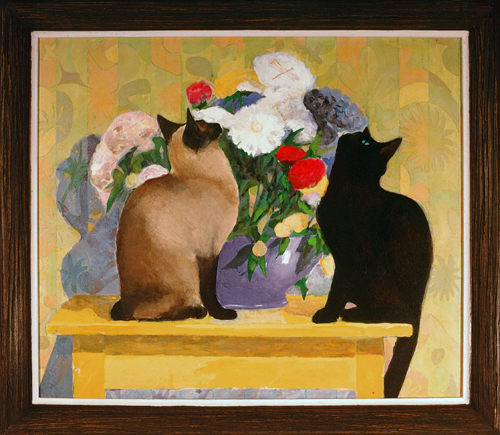
Couch Painting 6 (Lord & Taylor series) by Es Que, 1968/2010
18" x 18", framed archival digital print stretched on canvas, ed. of 5, $3,500
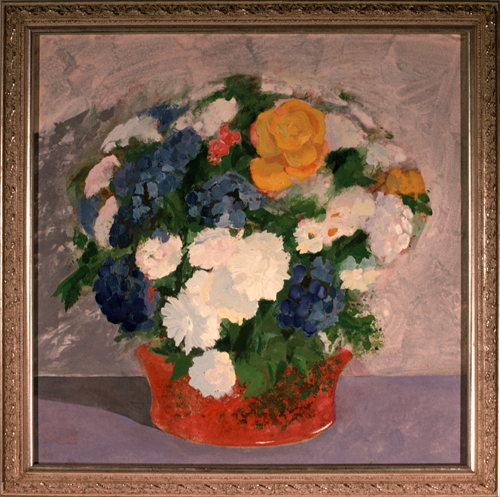
Couch Painting 7 (Lord & Taylor series) by Es Que, 1968/2010
18" x 18", framed archival digital print stretched on canvas, ed. of 5, $3,500
scroll down for more work
SEPTEMBER 28
click on the picture below to see a larger image
PROPOSAL, 2015
22" x 30", Acrylic and pastel on paper, $7,500
KALTENBACH ANNOTATIONS:
This is a Nuclear Work that I consider to be relatively hopeful
and also to its credit less of a political rant. It is an invitation to join
together in a relationship like a perfect marriage to encourage a loving and
caring way to live with each other – as the great 1971 Coke commercial sang,
"I'd like to teach the world to sing in perfect harmony." And in this project I
got to enjoy the contemporary art cultural incorrectness of certain banned
materials: Black Velvet! Yuck – Yum!
WORKS THAT RELATE TO PROPOSAL:
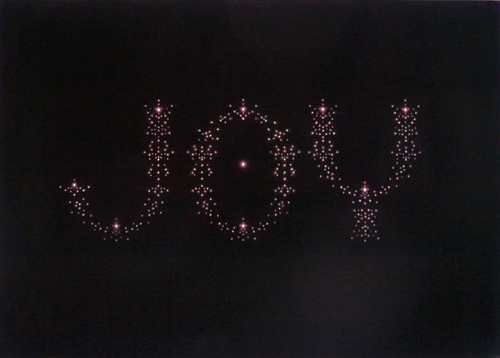
STAR PLOUGH, 1995
34" x 48", acrylic on black velvet, Price on Request
scroll down for more work
SEPTEMBER 29
click on the picture below to see a larger image
INCANDESCENT WAFER, 2007
22" x 30", Pastel on paper, $7,500
KALTENBACH ANNOTATIONS:
This represents the relationship made possible by the life and
death of Jesus Christ. What I refer to is not religious philosophy but a joyful
life experience that is available to anyone who wants it and is willing to ask
for it. This is a surrender so counter intuitive that it requires a miraculous
crossing of the borders of the logically possible.
For me this divine adoption was an answer to my fears and loneliness; it expanded my world view in both time and space. It also changed my circle of friends to some extent due to the amazingly cultural incorrectness of this paradigm shift in my life. The wrongness of being a Christian in terms of the norms of the society of contemporary art has introduced me to the experience of acceptable prejudice. This has been the dark side of this most wonderful change. It is not the first time I've known prejudice. I remember it clearly from when I was a long haired, beaded hippy in the late sixties.
I think I have a fairly clear understanding of what the root causes of this disaffection are. First as a culture we Christians are very critical of the private choices that people make in their lives. We try to politically control the norms of our culture. Why we do this is a mystery to me. Christians are taught that we can't improve ourselves the tiniest bit by our own efforts; but that God can and is eager to do this for anyone who desires it. We don't have an ounce of faith that is of our own creation but we are given all that we are willing to use. God's primary interest is to draw us into close relationship with Him. We learn to ask that His will be done on Earth. We are taught that faith is not some supernatural power but the simple belief that God will do what He says He will do. So if we want God's willed changes to occur on Earth, whether in terms of nations or individuals we can ask for that and accept the fact that it will be.
WORKS THAT RELATE TO INCANDESCENT WAFER:

LIVING TRUTH LOVES LIGHT, 1995
22" x 30", pastel on paper, $7,500
scroll down for more work
SEPTEMBER 30
click on the picture below to see a larger image
SPARK ANGEL, 2015
19" x 28", Digital photograph, ed. of 10, $3,500
KALTENBACH ANNOTATIONS:
This project is a plan to set a spotlight behind a 9" circular
opening in a museum wall. The light is to shine through the hole into the room.
This work represents the revisiting of a concept from an installation that was
done at UC Davis in 1968. It involves the use of light that is too bright to
look at directly. I used a 5000 watt theater spotlight aimed straight down at
the floor onto a 12x12 square of the kind of reflective beads that are mixed
with the paint used for the lines on freeways. The viewers were allowed to
remove their shoes and socks and to walk out on it which was like walking on
sand that reflected the spectrum.
The story this work brings to mind is of my entry into the church and my Ash
Wednesday encounter. In this narrative I again come up against my position as an
unreliable witness. Let me count the reasons to not believe what I write. I am
an artist who conceived the idea that the lie is an effective art expression. I
saw that belief in the reality of the work is a way to increase its
effectiveness and that the creation of an image in the mind is a complete work
of art and a step toward a pure minimalism.
Then there is my involvement with psychedelic drugs. The reason we hippies took
them was to see through the mundane reality provided and limited by our senses
and our consensus world view. This escape worked so well for me that there was
good evidence that my mind had jumped the rails and slipped its moorings; bats
had apparently gotten into my belfry. Living with this reputation made it
prudent to keep confidential the unbelievable things seen in a normal state of
mind. Instead of keeping these visions to myself I was effusively open about
them. This Ash Wednesday encounter is one of the best examples of that. All I
can say is that believing this story probably won't be that important for you.
It undoubtedly won't be enough to convince you of the benefit of going through
the conversion that preceded this event in my life. Speaking personally, it was
necessary to have my own experience; reading about someone else's life has never
moved me to take a step as big as complete surrender.
The shift from my relationship with God to Christianity happened over several
months. I'll just say that I was nonplussed when I had to admit that the
direction I was getting from God was real. My communication with God had been an
open communion with Him. He was allowing me to see the thinness of reality. I
was experiencing such impossible phenomena that speaking of it publically at the
Art Institute of San Francisco earned me the nickname, Crazy Kaltenbach. (I like
to spell it Krazy Kaltenbach.) Now I was being urged to trade it for ritualized
interaction that at best seemed staid and mundane and at worst seemed a
disconnection from the personal nature of my new love. What I had was a precious
friendship; and now I was being asked to trade it for religion. To my surprise
my relationship didn't change that much with my entry into the church and the
evolution that did happen was toward a closer and stronger bond.
This is the story of my vision. Much to my amazement I found myself joining the
Catholic Church. I was still completely naive about what was expected of me. Ash
Wednesday was approaching and I only knew a little about the fact that fasting
from food was involved. I mistakenly assumed that I would be going entirely
without food for the six weeks of Lent. I became more and more concerned that I
would not be able to survive that. By the Tuesday before Ash Wednesday I was
more than concerned; I was afraid. I was alone in my apartment and praying that
God would not let me die. I was kneeling with my forehead to the floor. Suddenly
I saw a child sitting on a marble wall. I saw this in my head with my eyes
closed. It was crystal clear, eidetic and pristine. The child was looking off to
my right. He turned and smiled at me, his face shining. He was filled with a
brilliant light. This lasted for less than five seconds. Then he disappeared and
in his place I noticed that there was a floral relief on the wall. It was
heraldic and in the center of the medallion was a lion's head. The lion yawned
and the wall disappeared. I didn't move for quite a while. Filled with peace, I
was thinking that the memory of this vision would remain with me for the rest of
my life. So far I am right about that.
I did fast during that Lent but friends were continually dropping by and asking
me to have lunch with them so although I ate less, I didn't stop eating; rather
I was able to stop thinking about feeding myself.
WORKS THAT RELATE TO SPARK ANGEL:

Untitled installation, 1968
12' x 12', freeway paint beads in square with 5,000 watt theater spotlight from directly above